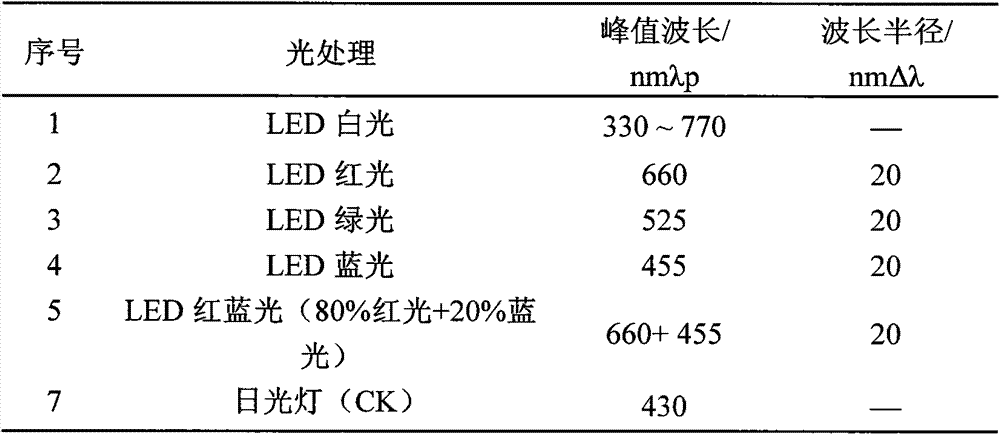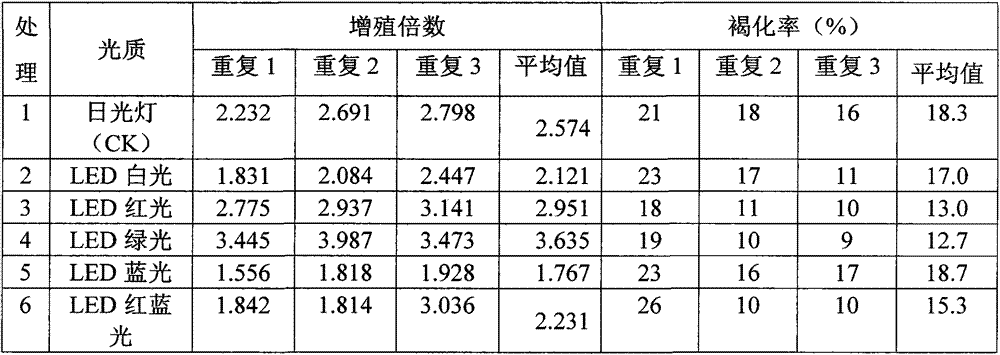Light regulation and control method for tissue culture and multiplication of camptotheca acuminata decaisne calluses
A technology of callus and light regulation, applied in the field of plant cultivation, can solve problems such as mercury content, environmental pollution, and single light quality, and achieve the effects of increasing induction rate and proliferation rate, reducing production costs, and reducing environmental pollution
- Summary
- Abstract
- Description
- Claims
- Application Information
AI Technical Summary
Problems solved by technology
Method used
Image
Examples
Embodiment 1
[0016] Take the young stems of Campyloditi radicis that are free from diseases and insect pests in the same year as explants. After picking and cleaning the stems, sterilize them in 75% ethanol solution for 1 min, put them into 0.1% mercuric chloride solution for further disinfection for 5 min, rinse them with sterile water for 3-4 times, dry them with sterile filter paper, and set aside.
[0017] Cut the stems into 2-3 mm small pieces, and inoculate them into the following four callus induction media respectively, inoculate 15 bottles of each medium, and inoculate 5 explants in each bottle, and transfer to Cultivate under light, culture temperature (25±2)°C, light intensity 1000-1500lx, light time 12h / day, light source is fluorescent lamp. The experiment was repeated 3 times.
[0018] ①MS+0.1mg / L KT+4mg / L2,4-D
[0019] ②MS+0.5mg / L KT+4mg / L2,4-D
[0020] ③MS+2mg / L6-BA+2mg / L NAA+2mg / L2,4-D
[0021] ④MS+0.5mg / L6-BA+2mg / L NAA
[0022] The agar of the above 4 kinds of media i...
Embodiment 2
[0025] Subculture the callus induced on No. ① and No. ② media respectively, and the subculture media used are:
[0026] ④MS+2.0mg / L6-BA+0.5mg / LNAA
[0027] ⑤MS+0.5mg / L KT+4.0mg / LNAA
[0028] (⑥B5+0.5mg / L KT+1.0mg / LNAA+0.5mg / L2, 4-D
[0029] The subculture conditions are culture temperature (25±2)°C, light intensity of 1000-15001x, light time of 12h / day, and fluorescent lamp as light source.
[0030] After 30 days of subculture, observe and count the subculture of induced callus on No. ① and No. ② media, and find that: the subculture of callus induced on No. ① media grows well on B5 (⑥ No.) media , more than 85% of the calli are loose in structure, easily scattered, light and transparent in color, and are good calli, while some of the calli subcultured on MS (4 and 5) medium have water stains on the surface Some are too compact and grow slowly, which is not conducive to the continued growth of callus; the subculture of callus induced on medium ② is not good, and it is found ...
Embodiment 3
[0033] The excellent callus subcultured on No. ⑥ medium was transferred and proliferated. The transfer medium was still No. ⑥, and the transfer container was a petri dish with a specification of 90*15mm. After the transfer, the petri dish was placed in a fluorescent lamp and Cultivate under 5 LED light sources with different light qualities, put 9 petri dishes under each light, and repeat 3 times. Adjust the LED light control software and the distance between the light source and the petri dish so that the amount of light is 105 μmol m -2 ·s -1 around, the photoperiod is 16h·d -1 , cultivated for 30 days. The relative humidity of the culture room is 70%±5%, and the temperature is (24±1)°C.
[0034] Wherein, the light source is an LED lamp purchased from Hangzhou Hanhui Photoelectric Technology Co., Ltd. See Table 1 for specific technical parameters.
[0035] Table 1 Main technical parameters of different light quality LED light sources
[0036]
[0037] After 30 days ...
PUM
 Login to View More
Login to View More Abstract
Description
Claims
Application Information
 Login to View More
Login to View More - R&D
- Intellectual Property
- Life Sciences
- Materials
- Tech Scout
- Unparalleled Data Quality
- Higher Quality Content
- 60% Fewer Hallucinations
Browse by: Latest US Patents, China's latest patents, Technical Efficacy Thesaurus, Application Domain, Technology Topic, Popular Technical Reports.
© 2025 PatSnap. All rights reserved.Legal|Privacy policy|Modern Slavery Act Transparency Statement|Sitemap|About US| Contact US: help@patsnap.com


